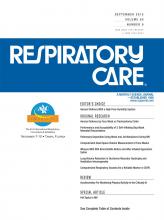In reply:
We thank Drs Lemyze and Esquinas for their interest in our work.1 The International Classification of Sleep Disorders, 3rd edition,2 defines obesity hypoventilation syndrome (OHS) as the combined presence of obesity (body mass index >30 kg/m2) with awake arterial hypercapnia (PaCO2 > 45 mm Hg) and sleep-disordered breathing in the absence of other causes of alveolar hypoventilation, such as COPD. It is an important cause of chronic respiratory failure.3 Therefore, it is very important to raise awareness of this disease. As you mentioned, these patients are frequently misdiagnosed in out-patient clinics, primary care and intensive care units as having COPD or asthma.4,5 OHS diagnosis is underestimated, and most OHS patients are given bronchodilator and long-term oxygen therapy. Additionally, most obese patients are discharged from the emergency department and ICUs without long-term noninvasive mechanical ventilation, with only 30% of hospitalized patients receiving a correct diagnosis of OHS when admitted with hypercapnic respiratory failure.4,6 Generally, the diagnosis of OHS as the cause of respiratory failure is not appreciated until referral to a respiratory physician has been made.
Nearly 90% of OHS patients have co-existing obstructive sleep apnea (OSA).7,8 Obese patients are mostly referred to the sleep laboratory due to suspicion of OSA. Another problem is that OHS has been incorrectly considered to be a severe form of OSA.9 Although the diagnosis of OHS may not be difficult for sleep specialists and chest physicians, the exact OHS frequency is still not known because capnography and arterial blood gas analysis, which are required for diagnosis, are not routinely performed in sleep laboratories. This may result in inadequate treatment. Because some OHS patients do not benefit from CPAP, bi-level positive airway pressure may be a better choice.
In light of these data, we aimed to improve the awareness of OHS with our article. For this aim, we tried to highlight the differences between OHS and pure OSA in obese subjects. We selected individuals who were referred to the sleep laboratory because we would have the chance to find more OHS subjects. We thought that finding the differences between OHS and pure OSA would improve the diagnostic process. Having higher serum bicarbonate level is one of the differences between OHS and OSA. Although arterial blood gas is not a very invasive procedure, more practical less invasive or noninvasive methods will improve the diagnostic process. In this context, we evaluated serum bicarbonate. Serum bicarbonate can be useful not only in sleep laboratories but also in primary care, out-patient clinics, and intensive care units. This less invasive test can be preferred to arterial blood gas.
OHS is a serious disorder associated with increased morbidity and mortality.10 Therefore, early recognition is essential to prevent complications. Thus, we conclude that studies addressing the characteristics of OHS subjects and practical diagnostic tests should be performed in obese subjects. Our results indicate that serum bicarbonate will improve the diagnostic process of OHS.
We appreciate sincerely your point of view. Also, we thank you for analyzing our article in such detail.
Footnotes
The authors have disclosed no conflicts of interest.
- Copyright © 2015 by Daedalus Enterprises











